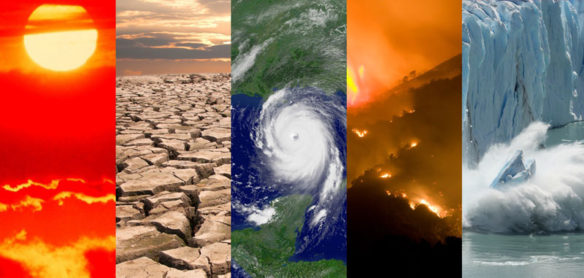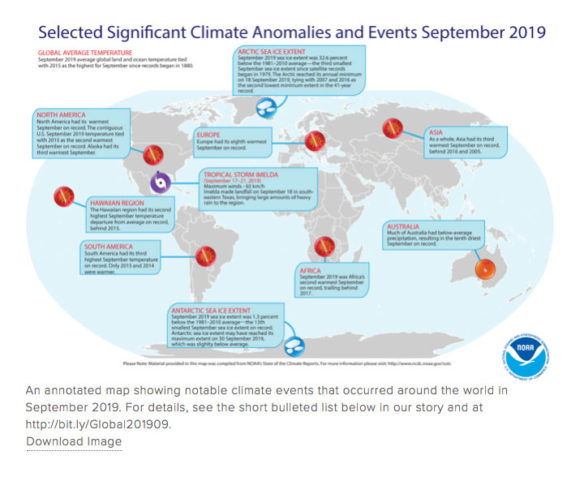
By NOAA;
The globe continued to simmer in exceptional warmth, as September 2019 tied with 2015 as the hottest September in NOAA’s 140-year temperature record. The month also capped off another warm year so far, with the globe experiencing its second-warmest January through September (YTD) ever recorded.
Below are highlights from NOAA’s latest monthly global climate report:
Climate by the numbers
September 2019
The average global land and ocean surface temperature for September 2019 was 1.71 degrees F (0.95 degrees C) above the 20th-century average and tied 2015 as the highest September temperature departure from average since global records began in 1880.
Septembers for 2015, 2016 and 2019 were the only Septembers with a global land and ocean surface temperature departure from average greater or equal than 1.62 degrees F (0.90 degrees C).
September 2019 was also the 43rd consecutive September and the 417th consecutive month with temperatures — at least nominally — above the 20th-century average.
Year to date | January through September
The first nine months of the year each had a global land and ocean temperature departure from average that ranked among the five warmest for their respective months. This gave way to the second-warmest January-through-September period in the 140-year record with a temperature of 1.69 degrees F (0.94 degrees C) above the 20th-century average. This was 0.22 degrees F (0.12 degrees C) cooler than the record-warm year to date set in 2016 and only 0.02 degrees F (0.01 degrees C) warmer than the now third- warmest year to date set in 2017.


An annotated map showing notable climate events that occurred around the world in September 2019. For details, see the short bulleted list below in our story and at http://bit.ly/Global201909.
More notable climate events in this report
- North America had its warmest September since continental records began in 1910 at 3.10 degrees F (1.72 degrees C). South America, Africa, Asia, the Gulf of Mexico and the Hawaiian region had a top-three warmest September on record.
- The Arctic sea ice coverage (extent) for September was the third lowest on record at 32.6% below the 1981–2010 average. The Arctic reached its annual minimum sea ice extent of 1.60 million square miles on September 18, marking the end of the melt season. The Arctic sea ice minimum extent for 2019 tied with 2007 and 2016 as the second lowest minimum extent in the 41-year record.
- The Antarctic sea ice extent for September was 1.3% below the 1981-2010 average and the 13th-smallest September extent in the 41-year record.









